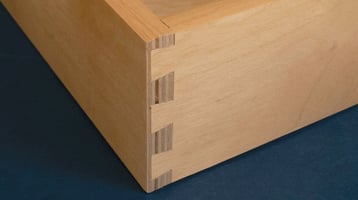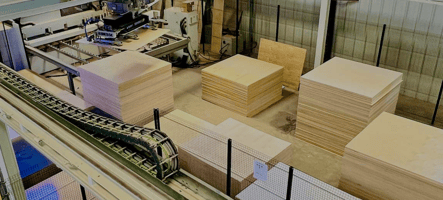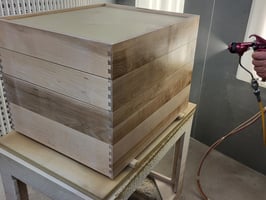If you are a cabinetmaker, furniture manufacturer, or woodworker who produces drawer boxes,...
6 Steps for Ensuring the Production of Quality Furniture or Cabinets
Drawer finishing, the process of preparing and applying a protective coating to the drawer, is essential to the appearance and functionality of furniture and cabinets. An unfinished drawer in a finished piece of furniture or cabinet is like pairing a steak that is grilled to perfection with a raw potato. It’s unpleasant to look at and highly impractical.
Step 1: Sanding and Finishing of Top Edges -- To help ensure that the drawer can absorb the protective coating most effectively, the best drawers have their top edges sanded and finished before they are assembled.
Step 2: Flat Finish Line -- Then, the part is sent through the UV (ultraviolet) Flat Finish Line, where it gets sanded before the finish is applied and the part is cured. This process occurs twice, with a finer sanding belt applied to the part on the second pass.
Step 3: Assembly; Step 4: Sanding; and Step 5: Spray Coating & Sealer-Sanding -- After the drawer is assembled, the drawer’s exterior is sanded to smooth the dovetail joint. Then, a coat of finish is manually applied in the spray booth. The drawer is then dried before it is sealer-sanded by hand.
Step 6: Finish Coating -- Lastly, the final coat of finish is sprayed onto the drawer. After the finish has dried, drawers are wiped down to remove dust or overspray that the drawer may have acquired in the drying process.
The only automated process occurs in Step 2, the UV Finishing Line. All other sanding and applications of finish are performed manually.
In contrast, not following the proper steps can result in a drawer that has dry or rough spots and a dull appearance. Whether a drawer is made from hardwood or plywood, the process is the same.
Advantages of a Quality Finish
 What separates a quality finish from an ordinary or sub-standard one is the depth of the sheen. If the finish is smooth to the touch, fills tight joints, and shows no or few scratches, it passes the quality test. With moisture being wood’s worst enemy, a superior finish will prevent swelling and shrinking (expansion and contraction) that can occur when humidity levels change as well as help preserve the wood and prevent it from rotting.
What separates a quality finish from an ordinary or sub-standard one is the depth of the sheen. If the finish is smooth to the touch, fills tight joints, and shows no or few scratches, it passes the quality test. With moisture being wood’s worst enemy, a superior finish will prevent swelling and shrinking (expansion and contraction) that can occur when humidity levels change as well as help preserve the wood and prevent it from rotting.
By properly following the six steps in the finishing process, including using the correct sanding grits, the customer will receive a drawer that is smooth to the touch and well-protected.
As a result, the furniture will maintain its appearance and remain functional for a longer time than it otherwise would.
When partnering with a drawer box manufacturer, it is important to look for one that sands its drawers after assembly and before the finish is applied. Although it seems like common sense to sand between those two steps in the manufacturing process, many manufacturers do not do so to save time and money. What they are doing, however, in many instances is compromising quality and diminishing the value of what they are providing their customers. As we’ve always said, don’t cut corners: dovetail them!
For more details on the features and benefits of quality finishes on drawers made of hardwood, plywood, and other materials...





